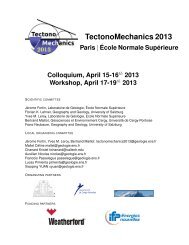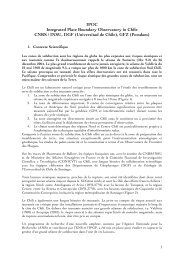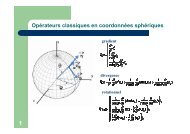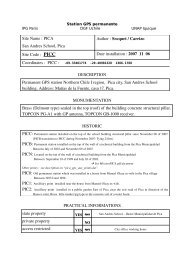PDF file - Laboratoire de Géologie de l'Ecole normale supérieure - Ens
PDF file - Laboratoire de Géologie de l'Ecole normale supérieure - Ens
PDF file - Laboratoire de Géologie de l'Ecole normale supérieure - Ens
You also want an ePaper? Increase the reach of your titles
YUMPU automatically turns print PDFs into web optimized ePapers that Google loves.
VIGNY ET AL.: ARABIA PLATE MOTION<br />
Figure 3. Arabian sites velocities in the ITRF2000 reference frame, relative to Arabia <strong>de</strong>fined in this work. Black<br />
arrows <strong>de</strong>pict our solution, white arrows are for McClusky et al. [2000]. For our solution, ellipses show the 99%<br />
confi<strong>de</strong>nce level of the velocity uncertainties given in table 2. Numbers next to arrow heads indicate the station<br />
velocity in mm/yr.<br />
clearly outsi<strong>de</strong> the <strong>de</strong>forming zone: CBL0, LLL0 and<br />
GOR0 [Vigny et al., submitted, 2004]. Inversion of the<br />
velocities at these 6 sites leads to an angular velocity<br />
vector (47.69°N, 98.32°W, 0,330°/Myr). In spite of a<br />
poor fit at SEY1 (4 mm/yr), the RMS residual on the 6<br />
velocities is 0.8 mm/yr (Figure 5). We checked the<br />
stability of our solution in the same way as for Africa.<br />
The unweighted inversion leads to nearly the same<br />
8<br />
angular velocity vector (only the latitu<strong>de</strong> differs by<br />
0.04°) but removing SEY1, for which the time series<br />
shows numerous gaps, slightly changes the solution<br />
(48.12°N, 97.75°W, 0.329°/Myr) (Table 3). Our<br />
solution for Somalia thus significantly differs from<br />
previous ones because it uses constraints in the northern<br />
part of the plate (sites CBL0, LLL0 and GOR0). Sella et<br />
al.’s [2002] and Fernan<strong>de</strong>s et al.’s [2003] mo<strong>de</strong>ls show






